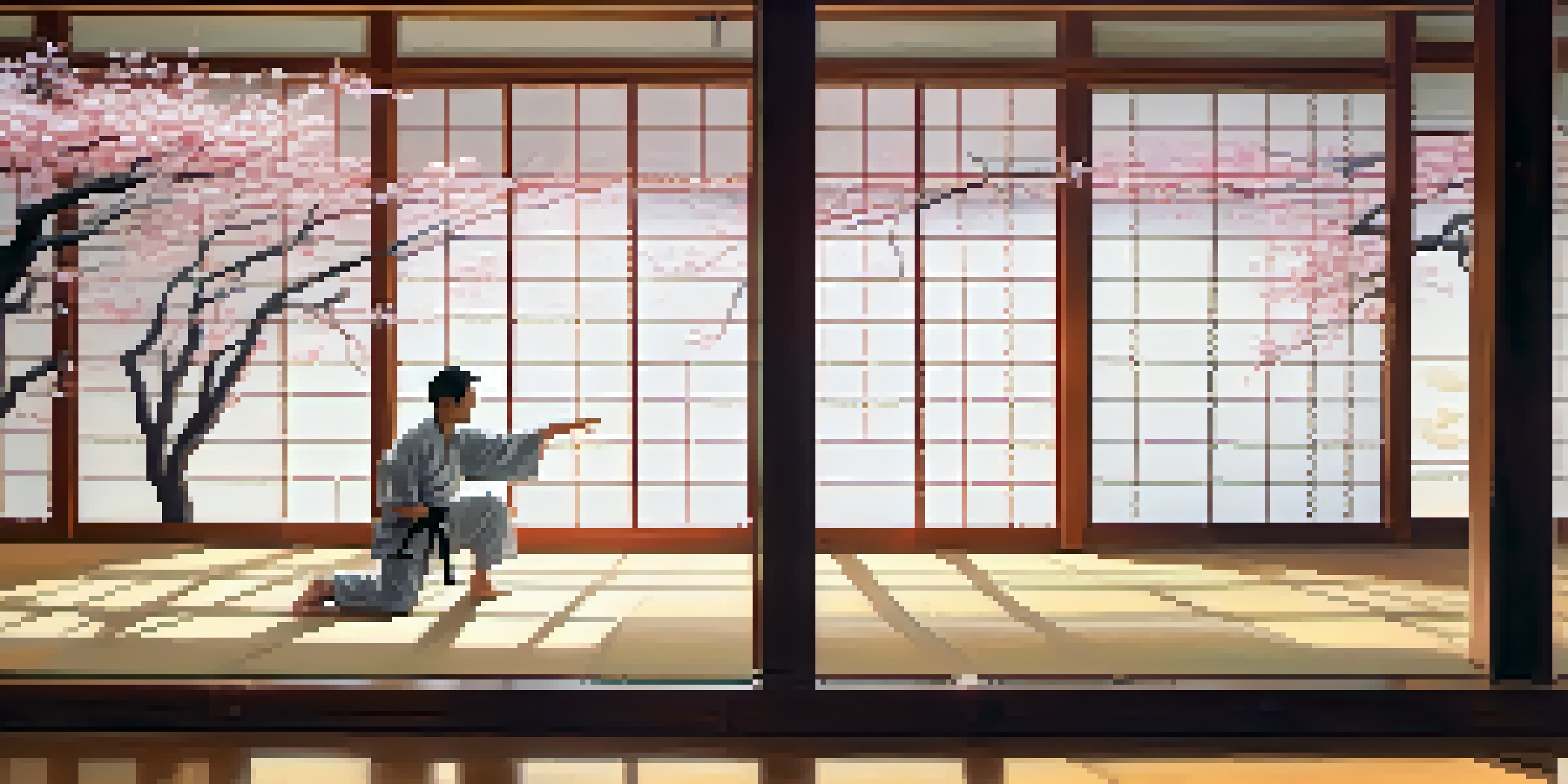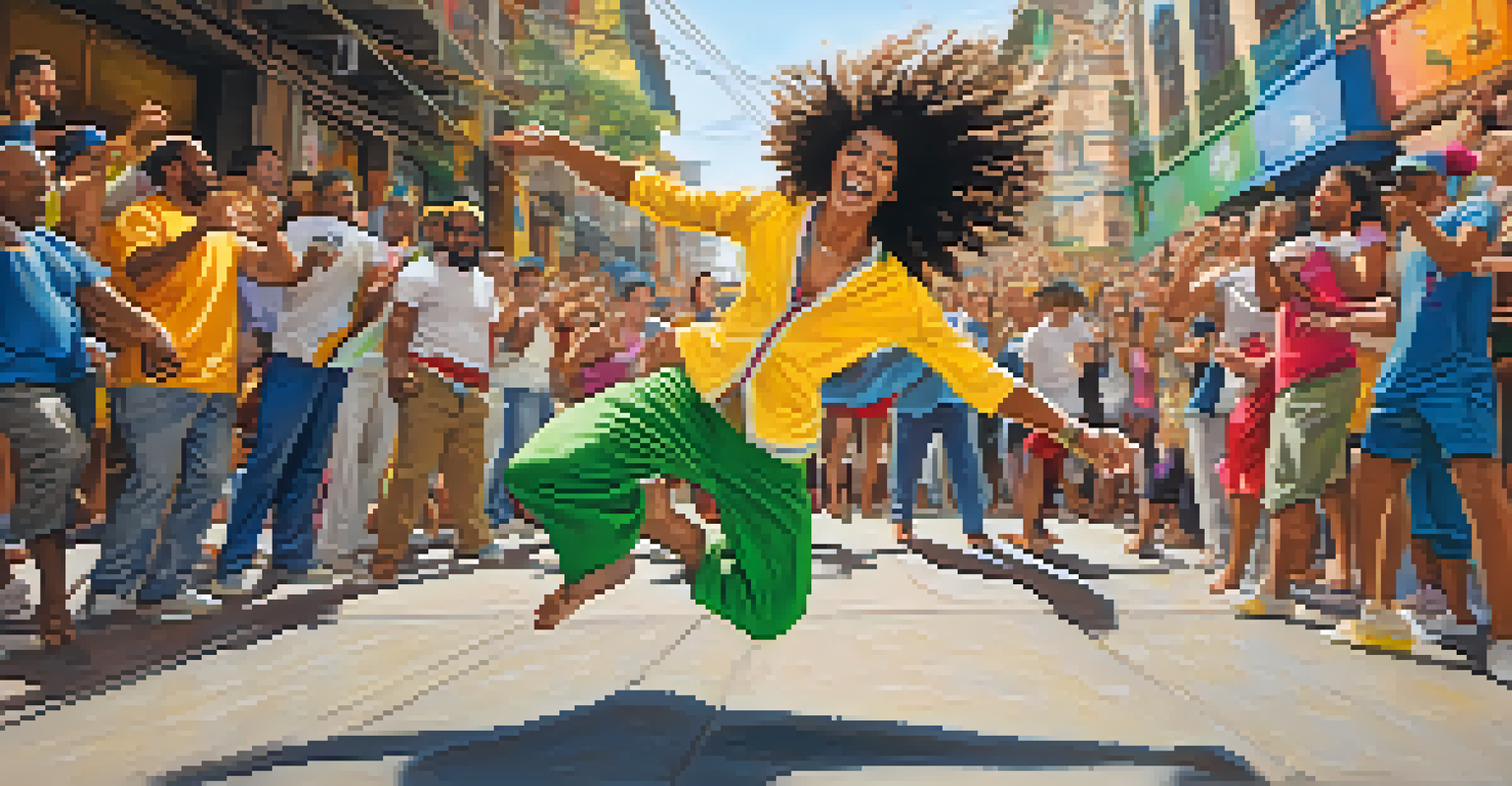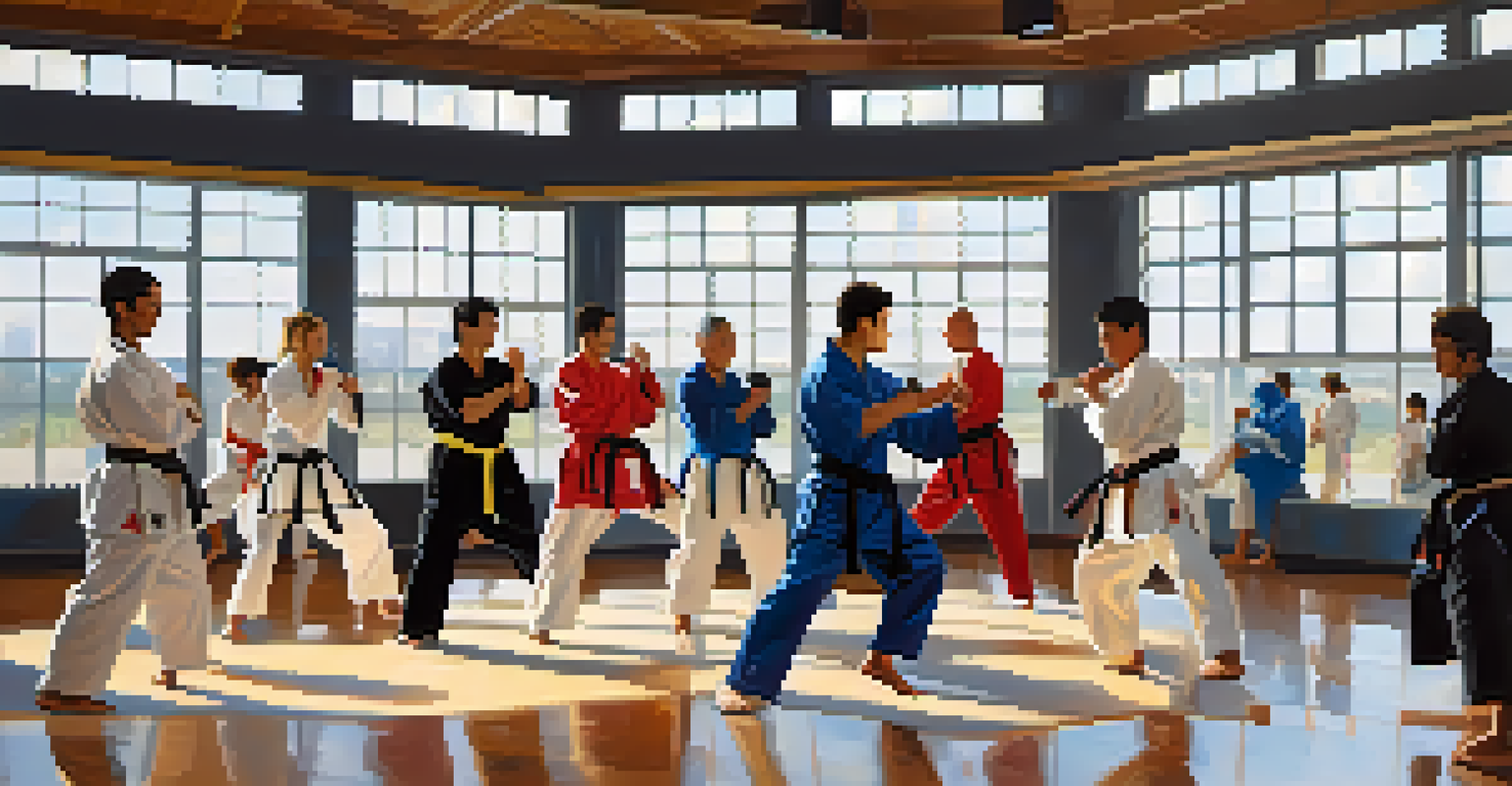Martial Arts and Globalization: A Historical Overview

The Origins of Martial Arts Across Cultures
Martial arts have deep roots in various cultures, often developed as a means of self-defense, military training, or spiritual discipline. For instance, ancient Chinese martial arts, like Kung Fu, originated around 4,000 years ago, influenced by philosophical teachings such as Taoism and Confucianism. Similarly, in Japan, disciplines like Judo and Karate emerged from a rich history of samurai training, showcasing a focus on honor and discipline.
Martial arts is not about fighting; it's about finding peace within yourself.
These early martial arts not only served practical purposes but also reflected the values and beliefs of their societies. The emphasis on respect, discipline, and personal growth is evident in many styles, which often incorporate rituals and traditions unique to their cultural heritage. For example, the bowing ceremony in Karate signifies respect, while the meditative practices in Tai Chi highlight the connection between mind and body.
As these martial arts spread beyond their borders, they began to intertwine with other cultural practices, leading to the rich tapestry of styles we see today. This early globalization of martial arts laid the foundation for their evolution into modern forms, illustrating how cultural exchange can enhance traditional practices.
Colonialism and the Spread of Martial Arts
The age of colonialism dramatically impacted the evolution and dissemination of martial arts. European powers often sought to control and adapt local fighting styles to serve their military needs, influencing the development of these practices in the colonies. For example, during British colonial rule in India, the local martial art of Kalaripayattu was studied and adapted by British officers, sparking interest in Indian fighting techniques.

This period also saw the emergence of hybrid martial arts, blending local techniques with Western influences. As colonized nations pushed back against foreign rule, martial arts became symbols of resistance, such as in the case of the Filipino martial art of Arnis, which was developed as a form of self-defense against Spanish colonizers. These historical contexts illustrate how martial arts evolved in response to external pressures.
Cultural Roots of Martial Arts
Martial arts originated from various cultures as means of self-defense, military training, and spiritual discipline, reflecting societal values.
Furthermore, the spread of martial arts during this time laid the groundwork for their global appeal. As practitioners from different backgrounds began to share and adapt techniques, the seeds were sown for a worldwide interest in martial arts that would grow in the coming decades.
The Rise of Global Martial Arts Competitions
As the 20th century unfolded, martial arts began to gain popularity beyond their countries of origin, thanks in part to the rise of global competitions. Events like the World Karate Championships and the International Brazilian Jiu-Jitsu Federation tournaments showcased diverse styles, drawing practitioners and fans from around the globe. This competitive environment fostered camaraderie and mutual respect among martial artists, regardless of their backgrounds.
The ultimate aim of martial arts is not having to use them.
Television and media played a significant role in this globalization, with martial arts films starring icons like Bruce Lee and Jackie Chan captivating audiences worldwide. These films not only popularized specific styles but also presented martial arts as a form of entertainment, bridging cultural gaps and sparking interest in training. For many, these cinematic portrayals ignited a passion for martial arts that crossed borders.
The increasing popularity of mixed martial arts (MMA) in recent years has further blurred the lines between different styles, creating a melting pot of techniques. MMA competitions have become a global phenomenon, showcasing the best of various martial arts and encouraging practitioners to learn from multiple disciplines. This evolution reflects the dynamic nature of martial arts in a globalized world.
Cultural Exchange and Adaptation of Martial Arts
Globalization has led to significant cultural exchange, allowing martial arts to adapt and evolve. As practitioners from different backgrounds come together, they share techniques, philosophies, and training methods, enriching their respective styles. For instance, the incorporation of yoga practices into martial arts training emphasizes flexibility and mental focus, demonstrating how diverse influences can enhance traditional techniques.
Moreover, the adaptation of martial arts to fit local contexts has resulted in the emergence of new styles. Capoeira, a Brazilian martial art combining dance and music, is a prime example of how cultural fusion can create something entirely unique. The blending of African and Brazilian traditions shaped Capoeira into a vibrant expression of identity and resilience.
Globalization's Impact on Practices
The globalization of martial arts has led to cultural exchange and the emergence of hybrid styles, enriching traditional practices.
This ongoing evolution highlights how martial arts are not static but dynamic, continually shaped by the cultural and social landscapes in which they exist. As practitioners embrace this exchange, they contribute to a living tradition that honors its roots while embracing change.
The Role of Technology in Martial Arts Globalization
In today's digital age, technology plays a pivotal role in the globalization of martial arts. Online platforms allow practitioners to connect, share knowledge, and learn from one another, transcending geographical barriers. This accessibility has led to a surge in online training programs, enabling individuals to explore various styles from the comfort of their homes.
Social media has also become a powerful tool for martial artists to showcase their skills and connect with a global audience. Influencers and content creators regularly share training tips, sparring sessions, and philosophical insights, creating a vibrant online community. This sense of belonging fosters a supportive environment where practitioners can grow and learn together, regardless of their physical location.
The impact of technology extends beyond just training; it has transformed how martial arts are perceived and marketed. Online competitions and virtual seminars allow practitioners worldwide to participate and engage in martial arts culture, further solidifying its global reach and appeal.
Challenges of Globalization in Martial Arts
While globalization has enriched martial arts, it also presents challenges that practitioners must navigate. One significant issue is the risk of cultural appropriation, where elements of a martial art may be adopted without understanding or respecting its origins. This can lead to misunderstandings and a dilution of the traditional values associated with the art, potentially alienating long-time practitioners.
Additionally, the commercialization of martial arts can overshadow their core teachings and philosophies. As martial arts become more mainstream, there's a temptation to prioritize profit over the authentic practice. This shift may result in watered-down versions of traditional styles that cater to consumer demand rather than preserving their true essence.
Challenges in Modern Martial Arts
While globalization offers opportunities for growth, it also poses challenges like cultural appropriation and commercialization that practitioners must address.
Addressing these challenges requires a collective effort from the martial arts community to promote awareness and respect for the history and traditions behind each style. By fostering open communication and education, practitioners can help ensure that martial arts continue to thrive while honoring their roots.
The Future of Martial Arts in a Globalized World
As we look to the future, the ongoing globalization of martial arts presents exciting possibilities for growth and innovation. With the rise of new technologies and teaching methods, practitioners will likely continue to explore and adapt techniques from various styles. This evolution can lead to the creation of hybrid practices that respect tradition while addressing modern needs.
Moreover, the increasing acceptance and appreciation of diverse cultures will contribute to the continued popularity of martial arts globally. As more people engage with martial arts, they will gain a deeper understanding of the values, philosophies, and histories embedded within each discipline. This knowledge fosters respect and encourages a more inclusive community.

Ultimately, the future of martial arts is bright, characterized by a blend of tradition and innovation. As practitioners worldwide come together to learn and grow, they will continue to shape the landscape of martial arts while honoring the rich histories that have brought us to this moment.